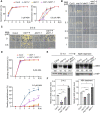COP1 positively regulates ABA signaling during Arabidopsis seedling growth in darkness by mediating ABA-induced ABI5 accumulation
- PMID: 35263433
- PMCID: PMC9134052
- DOI: 10.1093/plcell/koac073
COP1 positively regulates ABA signaling during Arabidopsis seedling growth in darkness by mediating ABA-induced ABI5 accumulation
Abstract
CONSTITUTIVELY PHOTOMORPHOGENIC1 (COP1), a well-characterized E3 ubiquitin ligase, is a central repressor of seedling photomorphogenic development in darkness. However, whether COP1 is involved in modulating abscisic acid (ABA) signaling in darkness remains largely obscure. Here, we report that COP1 is a positive regulator of ABA signaling during Arabidopsis seedling growth in the dark. COP1 mediates ABA-induced accumulation of ABI5, a transcription factor playing a key role in ABA signaling, through transcriptional and post-translational regulatory mechanisms. We further show that COP1 physically interacts with ABA-hypersensitive DCAF1 (ABD1), a substrate receptor of the CUL4-DDB1 E3 ligase targeting ABI5 for degradation. Accordingly, COP1 directly ubiquitinates ABD1 in vitro, and negatively regulates ABD1 protein abundance in vivo in the dark but not in the light. Therefore, COP1 promotes ABI5 protein stability post-translationally in darkness by destabilizing ABD1 in response to ABA. Interestingly, we reveal that ABA induces the nuclear accumulation of COP1 in darkness, thus enhancing its activity in propagating the ABA signal. Together, our study uncovers that COP1 modulates ABA signaling during seedling growth in darkness by mediating ABA-induced ABI5 accumulation, demonstrating that plants adjust their ABA signaling mechanisms according to their light environment.
© American Society of Plant Biologists 2022. All rights reserved. For permissions, please email: journals.permissions@oup.com.
Figures









Similar articles
-
ABD1 is an Arabidopsis DCAF substrate receptor for CUL4-DDB1-based E3 ligases that acts as a negative regulator of abscisic acid signaling.Plant Cell. 2014 Feb;26(2):695-711. doi: 10.1105/tpc.113.119974. Epub 2014 Feb 21. Plant Cell. 2014. PMID: 24563203 Free PMC article.
-
CONSTITUTIVELY PHOTOMORPHOGENIC1 promotes ABA-mediated inhibition of post-germination seedling establishment.Plant J. 2020 Jul;103(2):481-496. doi: 10.1111/tpj.14844. Epub 2020 Jun 17. Plant J. 2020. PMID: 32436306
-
U-box E3 ubiquitin ligase PUB8 attenuates abscisic acid responses during early seedling growth.Plant Physiol. 2023 Apr 3;191(4):2519-2533. doi: 10.1093/plphys/kiad044. Plant Physiol. 2023. PMID: 36715300 Free PMC article.
-
Light and abscisic acid interplay in early seedling development.New Phytol. 2021 Jan;229(2):763-769. doi: 10.1111/nph.16963. Epub 2020 Oct 25. New Phytol. 2021. PMID: 32984965 Review.
-
Exploring ABI5 regulation: Post-translational control and cofactor interactions in ABA signaling.Plant J. 2025 Feb;121(3):e17232. doi: 10.1111/tpj.17232. Plant J. 2025. PMID: 39911030 Review.
Cited by
-
Nitrate attenuates abscisic acid signaling via NIN-LIKE PROTEIN8 in Arabidopsis seed germination.Plant Cell. 2025 Mar 5;37(3):koaf046. doi: 10.1093/plcell/koaf046. Plant Cell. 2025. PMID: 40123384
-
Light signaling as cellular integrator of multiple environmental cues in plants.Physiol Mol Biol Plants. 2023 Oct;29(10):1485-1503. doi: 10.1007/s12298-023-01364-y. Epub 2023 Sep 28. Physiol Mol Biol Plants. 2023. PMID: 38076763 Free PMC article. Review.
-
Integration of ABA, GA, and light signaling in seed germination through the regulation of ABI5.Front Plant Sci. 2022 Aug 24;13:1000803. doi: 10.3389/fpls.2022.1000803. eCollection 2022. Front Plant Sci. 2022. PMID: 36092418 Free PMC article. Review.
-
Liquid-liquid phase separation of TZP promotes PPK-mediated phosphorylation of the phytochrome A photoreceptor.Nat Plants. 2024 May;10(5):798-814. doi: 10.1038/s41477-024-01679-y. Epub 2024 May 7. Nat Plants. 2024. PMID: 38714768
-
Identification of F-box proteins in ABA- and GA-regulated seed germination: interaction of GASA1 signalling peptide and ABA-induced ubiquitination.Philos Trans R Soc Lond B Biol Sci. 2025 May 29;380(1927):20240233. doi: 10.1098/rstb.2024.0233. Epub 2025 May 29. Philos Trans R Soc Lond B Biol Sci. 2025. PMID: 40439299
References
-
- Ang LH, Chattopadhyay S, Wei N, Oyama T, Okada K, Batschauer A, Deng XW (1998) Molecular interaction between COP1 and HY5 defines a regulatory switch for light control of Arabidopsis development. Mol Cell 1: 213–222 - PubMed
-
- Bauer D, Viczian A, Kircher S, Nobis T, Nitschke R, Kunkel T, Panigrahi KC, Adam E, Fejes E, Schafer E, et al. (2004). Constitutive photomorphogenesis 1 and multiple photoreceptors control degradation of phytochrome interacting factor 3, a transcription factor required for light signaling in Arabidopsis. Plant Cell 16: 1433–1445 - PMC - PubMed
-
- Chen K, Li GJ, Bressan RA, Song CP, Zhu JK, Zhao Y (2020) Abscisic acid dynamics, signaling, and functions in plants. J Integr Plant Biol 62: 25–54 - PubMed
Publication types
MeSH terms
Substances
LinkOut - more resources
Full Text Sources
Molecular Biology Databases

